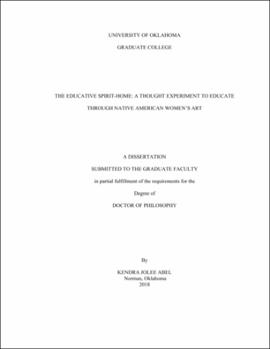| dc.description.abstract | Recognizing historical trauma experienced by indigenous peoples as contributing to social and educational problems for contemporary Native Americans (LaDuke 1999, 2002, 2005, Mihesuah 2003), specifically Native women (Mankiller 1993, 2004, Bird and Harjo 1998), this dissertation is a philosophical inquiry that assists in reinstating Natives’ authority over their aesthetic, educational, and cultural experiences. It examines Adrienne Rich’s “white man’s nostalgia” (Rich 1994, 140) as an erasure of marginalized groups’ human experiences and considers Jane Roland Martin’s concept of “education as encounter” (Martin 2011) as a method for Natives to create and reclaim control over educational experiences for themselves.
As its foundation, this study theorizes an educative spirit-home, a philosophical concept formulated by education as indigenous “red pedagogy” (Grande 2004), spirit (Brown 2001, Wuthnow 2001), and place (Basso 1996, Robbins 2016). It identifies critical features of an educative spirit-home as a place where: Natives have authority, aesthetic encounters improve lives, individuals feel connected, encounters and experiences are educative, educational spirits are transmitted, and individual and collective healing results. This dissertation claims that encounters with educational spirits located in contemporary indigenous women’s visual arts transform individuals and cultures. This dissertation analyzes educational spirits in artworks created by artists, Julie Buffalohead (Ponca Tribe of Oklahoma), J. Nicole Hatfield (Comanche and Kiowa), and Norma Howard (Choctaw and Chickasaw), representatives of Oklahoma tribes. By comparisons to the contrary case of Oklahoma Memorial Stadium, a miseducative spirit-home, that is a product of “cultural miseducation” (Martin 2002), and the borderline case, the Fred Jones, Jr. Museum of Art, an educational spirit-home, the implications of the educative spirit-home for contemporary Natives are further understood through a clear case of The Jacobson House Native Art Center, previous residence of the late Oscar Brousse Jacobson. | en_US |
